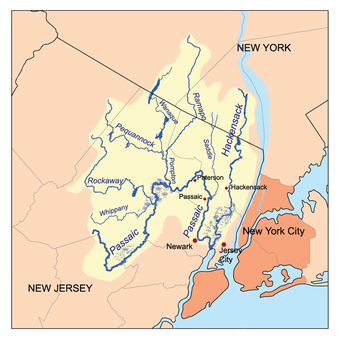
Back نهر پاسايك ARZ Passaic River CEB Passaic River German Río Passaic Spanish Passaici jõgi Estonian Passaic (rivière) French Passaic (fiume) Italian パセイック川 Japanese Пассаик өзені Kazakh Paseikas Lithuanian
| Passaic River Pahsayèk (Unami) | |
|---|---|
 | |
 The Passaic and Hackensack watersheds | |
| Etymology | Algonquian, meaning "peaceful valley"[1] |
| Location | |
| Country | United States |
| State | New Jersey |
| Counties | Hudson, Essex, Bergen, Passaic, Morris, Union, Somerset |
| District | Northern New Jersey, Gateway, Skylands |
| Cities | Newark,
Paterson, Clifton, Garfield, Elmwood Park, New Jersey Passaic |
| Physical characteristics | |
| Source | Unknown Pond |
| • location | Mendham |
| • coordinates | 40°45′44″N 74°34′39″W / 40.76222°N 74.57750°W |
| • elevation | 540 ft (160 m) |
| Mouth | Newark Bay |
• location | Newark |
• coordinates | 40°42′46″N 74°07′08″W / 40.71278°N 74.11889°W |
• elevation | 0 ft (0 m) |
| Length | 80 mi (130 km) |
| Basin size | 935 sq mi (2,420 km2) |
| Discharge | |
| • location | Little Falls |
| • average | 2,100 cu ft/s (59 m3/s) |
| • minimum | 36 cu ft/s (1.0 m3/s) |
| • maximum | 8,330 cu ft/s (236 m3/s) |
| Discharge | |
| • location | Chatham |
| • average | 320 cu ft/s (9.1 m3/s) |
| Basin features | |
| Tributaries | |
| • left | Rockaway River, Pompton River, Saddle River |
| • right | Dead River |
The Passaic River (/pəˈseɪ.ɪk/ pə-SAY-ik or locally /pəˈseɪk/ pə-SAYK[2]) is a river, approximately 80 miles (130 km) long,[3] in northern New Jersey. The river in its upper course flows in a highly circuitous route, meandering through the swamp lowlands between the ridge hills of rural and suburban northern New Jersey, called the Great Swamp, draining much of the northern portion of the state through its tributaries.
In its lower (southern) portion, it flows through the most urbanized and industrialized areas of the state, including along Downtown Newark. The lower river suffered from severe pollution and industrial abandonment in the 20th century. In April 2014, the U.S. Environmental Protection Agency (EPA) announced a $1.7 billion plan to remove 4.3 million cubic yards (3.3 million cubic metres) of toxic mud from the bottom of lower eight miles (13 km) of the river. It is considered one of the most polluted stretches of water in the nation, and the project is one of the largest toxic cleanups ever undertaken in the nation.[4]
- ^ "Passaic River | New Jersey, Map, & Facts | Britannica". www.britannica.com. March 13, 2024.
- ^ Martin, Jim. "Jim Martin", Schenectady Gazette, June 3, 1970. Accessed May 19, 2021, via Newspapers.com. "When you have to run 20 miles a day through a corridor of urban sprawl without bumping into Hackensack, South Orange (pronounced 'Arnj'), Passaic (pronounced 'Puh-sake'), Cedar Ave., Nutley or the Delaware-Lackawanna tracks, you are a human being of extraordinary determination."
- ^ PassaicRiver.com. "About the River." Accessed 2010-02-16. Archived October 10, 2008, at the Wayback Machine
- ^ Fallon, Scott (April 11, 2014). "$1.7 billion plan to clean up the Passaic River unveiled". The Record. Archived from the original on 2014-04-15.